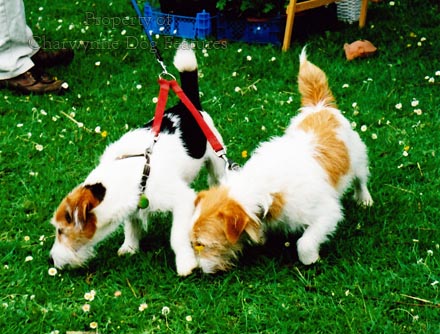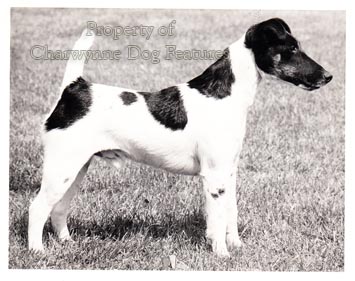596 Constructing a Lucas terrier
CONSTRUCTING THE SPORTING LUCAS
by David Hancock
 We live in times of great design consciousness and the design of any breed of dog with 'sporting' in its title needs thought. Ugly little varmint or cute little canine fashion model? Scarred canine miner or handsome reduced hound? What should a Sporting Lucas Terrier look like? Does its anatomy truly matter? It matters if you wish your breed to establish a type and for future progeny to conform to that set type. It is important to respect Lucas's prototype if the name itself is to have relevance. It doesn't matter if all you seek is 'any variety terrier', a charming pet, and broadly speaking, as long as it's small, terrierlike and somewhere between a Norfolk and a Sealyham. Brown Sealyhams and white Norfolks will always have their appeal but a breed with its own title and heritage shouldn't be a rough copy but a dstinct breed, with its own characteristics: size, coat texture, head shape, leg length and temperament. The fundamental template matters, as other sporting terrier breeds have discovered.
We live in times of great design consciousness and the design of any breed of dog with 'sporting' in its title needs thought. Ugly little varmint or cute little canine fashion model? Scarred canine miner or handsome reduced hound? What should a Sporting Lucas Terrier look like? Does its anatomy truly matter? It matters if you wish your breed to establish a type and for future progeny to conform to that set type. It is important to respect Lucas's prototype if the name itself is to have relevance. It doesn't matter if all you seek is 'any variety terrier', a charming pet, and broadly speaking, as long as it's small, terrierlike and somewhere between a Norfolk and a Sealyham. Brown Sealyhams and white Norfolks will always have their appeal but a breed with its own title and heritage shouldn't be a rough copy but a dstinct breed, with its own characteristics: size, coat texture, head shape, leg length and temperament. The fundamental template matters, as other sporting terrier breeds have discovered.
In his 'Sporting Terriers' of 1926, Pierce O'Conor wrote: "That the foxterrier of today is a great improvement, in so far as looks go, on his predecessors of forty or fifty years ago is beyond question, though whether he is better suited physically or morally for work underground is a matter of opinion". If O'Conor were alive today, I think he would strengthen those words even more and would not be a happy terrierman.
I believe that it is entirely fair to state that of all the types of dog ruined by the effects of the Kennel Club-approved show rings the Terrier Group has suffered the most. This is sad for a number of reasons: firstly, the Kennel Club was founded by sportsmen, with the Rev John Russell an early member and Fox Terrier judge; secondly, the breeders of those terrier breeds recognised by the KC boast of the sporting ancestry of their dogs -- and then dishonour it. And, thirdly, some quite admirable breeds of terrier have been degraded, even insulted, in this way. Discounting the Airedale, never an earth-dog more a hunting griffon, and farm dogs like the Kerry Blue and Wheaten Terriers, which were allrounders rather than specialist terriers, all show terriers (KC or working terrier show/game fair) should ideally only be called full champions if they have passed an underground test, however elementary.
In the United States, they are shaming us by conducting such tests, ranging from 'Introduction to Quarry' and 'Junior Earthdog' to 'Senior Earthdog' and 'Master Earthdog'. To date I know of no master earthdog tests being held but just under ten dogs hold the senior earthdog title. In the introduction test, the terrier (or working Dachshund) has two minutes to enter a ten foot tunnel, negotiate a 90 degree turn and 'work' the quarry for 30 seconds. The American enthusiasts say that "you put a dog down the hole but you get a terrier out of it". In the master earthdog test, acting in a brace, a dog has to follow a 100 foot scent trail to a hole, which is intentionally a false one, investigate the false den without giving tongue, then navigate 30 feet of tunnel, three 90 degree turns, a false exit, a constriction point and an obstacle.
Seventy years ago, Pierce O'Conor was advocating something similar. He described the French apparatus for trying terriers: a wooden conduit 7½" wide, sunk in the earth, with passing chambers, just over 50 feet long. Terrier-testing underground is so much more a basis for judging than any 'beauty show'. It tests, however artificially, the working instinct and character of the dog. It is both surprising and disappointing that at game fairs and country shows the underground testing of terriers isn't conducted. It would cost little to instal the equipment needed for such essential tests of terrier function. Perhaps future Sporting Lucas shows could use a series of construction pipes and covered runs to simulate an underground course to test the entry on the day.
The seeking of a working terrier construction would be strengthened by such a simple field test. But what format should 'a working construction' be based on? The original working fox terriers were barrel-chested and featured a fairly straight stifle and hock; the longer tibia and well-bent hock of the show ring terrier of today is not much use underground. But an even bigger difference lies in the shoulder angulation and depth of chest. Show Fox Terriers feature almost without exception upright shoulders and slab-sidedness but deep chests; neither of these physical attributes help an earthdog. Nor does the short back of the pedigree Fox Terrier, which reduces flexibility and overall suppleness. It does however produce a more compact-looking showy type of dog.
The craze for long heads in show terriers, exemplified most clearly in the smooth Fox Terrier, is rooted in the misguided belief that length gives power. You also hear the expression: "plenty of heart room", which is strange when the heart doesn't actually change size when the dog is exerting itself. Plenty of lung room is desirable, especially in terriers which run with the hounds. But it is rib-space which gives a dog lung room, not depth of chest. I have heard terrier show judges fault a very muscular terrier, used to hard exercise, for being 'loaded at the shoulders' when the fortunate dog had developed muscle which projected on the outside of its shoulders. Any individual accepting a judging appointment should question their own capability and 'eye for a dog' before proceeding.
Symmetry is important in most working animals; in a Fox Terrier measuring two feet from the top of its head to the ground, its front or spread should cover not more than eight inches in width, a proportion of at least 1 in 3. In his informative book "The Popular Fox Terrier" of 1950, Rosslyn Bruce, who drew on the knowledge of the Rev. A.J.Skinner, a breeder of working and show terriers, makes great play of correct proportions. His best all-purpose terrier came out showing that height at the withers should equal the length of the dog.
He also argued that the depth of chest should equal leg length. He sensibly argued against 'square' Fox Terriers, stating this encouraged upright shoulders, too short a back and faulty necks. He favoured a build which provided good reach of neck, flexibility of body and correct shoulder placement.
As dog-show exhibitors without working experience gained the ascendancy, these arguments were forgotten. In time, a judge like MacDonald Daly, despite owning coursing greyhounds, was advocating Fox Terriers with the physical attributes argued against by Rosslyn Bruce. The long muzzle, short back and upright shoulders are easily spotted and sadly are now the norm, held as the perfect earthdog blueprint, the ideal anatomy for a sporting terrier!
Sporting terrier enthusiasts will never show great interest in precise measurements, exact proportions or wordy descriptions of anatomical features. But balance, symmetry, correct proportions and physical soundness really do affect function and therefore performance in a hunting animal. Terrier show judges may prefer to judge entirely by eye and experience, but is this enough? A seminar of sporting terrier judges to bring on the younger judges would surely be of value. It would be interesting to hear, at such a seminar, what terrier show judges' decisions are actually being based on: gut feeling, their own preferences, previous winners, knowledge of anatomy?
Around 1880, the best terrier judge of that time, Edward Sandell, measured around 40 of the top hunt terriers, revealing some interesting dimensions. The averages were as follows: height 14½ inches, weight 17 to 20lbs, neck circumference 12¾ inches, span of thorax 20½ inches, span of loins 18½ inches, hock 4½ inches from ground and shoulder (leading edge) to root of stern 13½ inches. A measurement from point of shoulder to point of buttock would have given a length of around 14½ inches, the average height of these dogs. The most successful dog at that time was Carlisle Tack, (grand-daughter of the Rev. John Russell's bitch Fuss), all white, 17lbs, and described by Rawdon Lee as 'built on racing lines almost, without any lumber about him, and with powerful jaws.'
Twenty years later, Darley Matheson records in his 'Terriers' of 1922: "Quality of front is greatly sought after by breeders, but a beautiful front ought not to be allowed to overshadow poor hindquarters". This over-emphasis of one feature to the detriment of others is a curse. Some terriers are judged on their 'spannable thorax' whilst their stuffy necks, weak loins, short bodies and thin feet are overlooked. The sound construction of a terrier is about the whole dog never the seeking of perfection in one area. There is one area however which should always be emphasised in sporting terriers, and it is their spirit not their build; without 'attitude' no working dog is ever going to succeed. The character of a terrier is everything. Spirit does not mean snappy aggression, feistiness does not mean a desire to fight anything within reach, but a challenging nature, an energetic curiosity, a desire to explore, to investigate. Heeding experience in other terrier breeds will show the pitfalls - and the way forward. There has to be, too, genuine excitement around any emergent breed